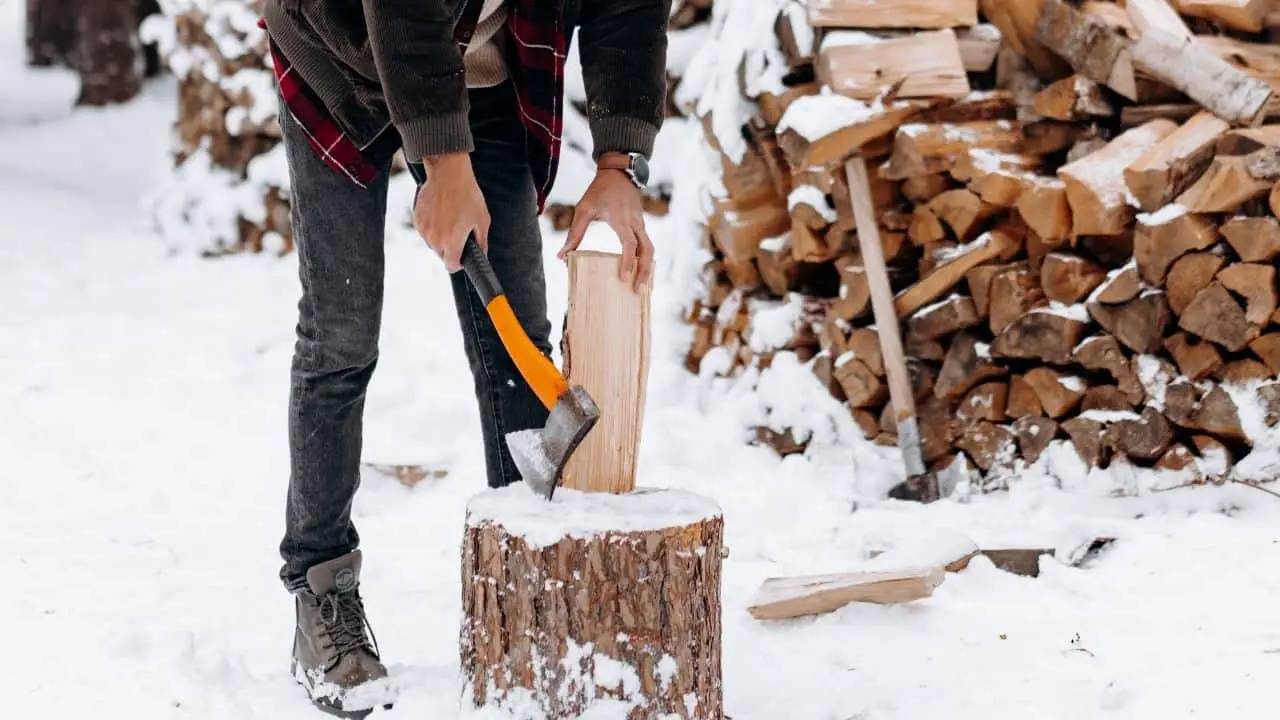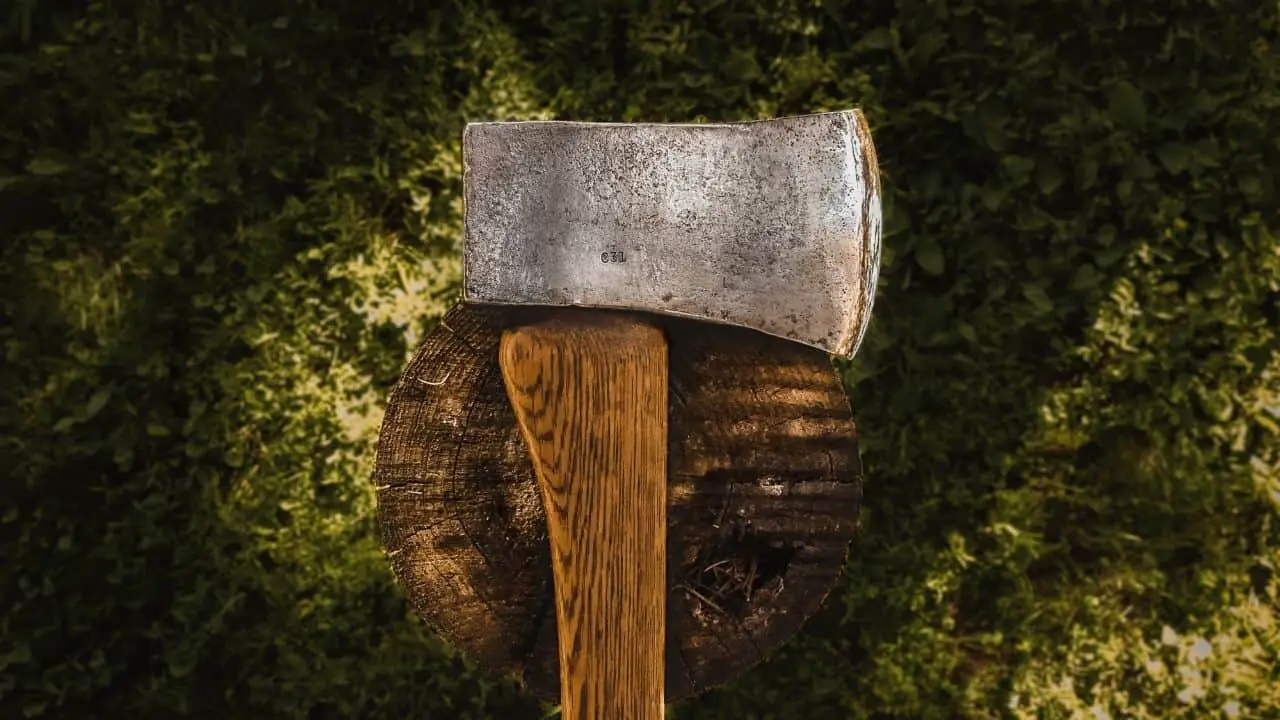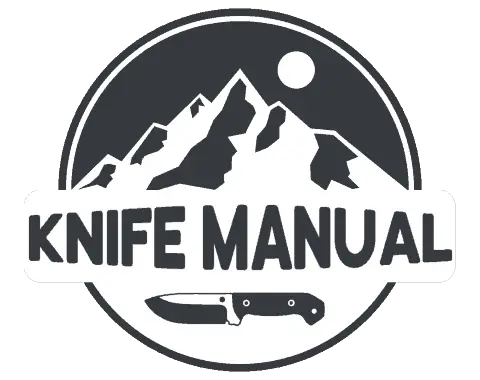If you just got a hatchet, or you’ve had one for a while but are just getting around to needing to sharpen it, it can be quite confusing to know how sharp your hatchet blade should be. After a ton of research and personal experience, here are my thoughts on how sharp a hatchet is supposed to be.
Whether you keep your hatchet sharp or dull comes down to personal preference. A sharp hatchet blade allows you to chop cleanly, is versatile, and is often safer due to its lessened chance of catching. A dull hatchet blade is less likely to chip or curl than a sharp blade, but it may chop slower.
When I first got a hatchet, it came pretty sharp out of the box. After a few months of use, the blade began to dull, and it became much harder to work with and cut wood. When I went to find out how sharp I should keep my hatchet, I found a TON of conflicting answers and information.
There is a ton of information out there, so let’s break it down and figure out how sharp YOUR hatchet should be specific to your needs.
Table of Contents
Are Hatchets Supposed To Be Sharp?

No one answer fits all with the question of how sharp a hatchet should be, and it primarily comes down to personal preference. Both sharp and dull hatchet blades have their advantages and disadvantages.
One thing that is pretty widely agreed upon is the shape of the bevel that you should have on a hatchet. Most people like a convex grind on their hatchets, which allows the tip to be sharp enough to initially dig into the material while also widening fast enough to split effectively.
How sharp you should keep your hatchet depends on many factors, including your preferences, the quality of your hatchet, what you use your hatchet to do, and many more.
In the next few sections, I’ll take a deep dive into the benefits and drawbacks of keeping your hatchet dull or sharp. Hopefully, you can take this information and come up with a decision for yourself.
Reasons to Keep Your Hatchet Extremely Sharp
Maintaining your hatchet and keeping it extremely sharp is very common due to its many advantages, which I’ll go over in more depth in a moment. To be honest, there are very few reasons why you might not want to keep your hatchet sharp.
Keeping your hatchet blade sharp takes a little bit of time every once in a while, but the added efficiency usually makes up for any time spent maintaining your blade. Ensuring your hatchet stays sharp doesn’t need to take very long either; you can generally get it done in less than fifteen minutes every so often.
There are many ways to go about sharpening your hatchet, but my article on how to sharpen your knife in the wilderness lays out a few techniques that you can apply to your hatchet’s blade.
If you are less experienced using a hatchet, I might shy away from recommending you keep your hatchet razor-sharp because any mistakes or slipups can be quite severe. Whether you are a complete beginner or you’ve been around the block a few times, it is always essential to use proper safety measures and be careful when using your hatchet.
A Sharp Blade Cuts Through Material Quickly
It’s sort of a known fact that a sharp blade will cut through most materials easier than a dull one, and hatchets are no exception.
With a sharp blade and a little bit of force behind your swings, most hatchets will get through any wood or material with ease. A sharp edge allows your hatchet to break into whatever you are chopping easily, and then the power behind your swing will split it.
In most cases, the sharper you make your hatchet blade, the faster it will chop and cut. However, if you sharpen your hatchet too much, the blade will be too thin and will easily crack or chip.
A Sharp Blade is Overall Much Safer
While it might seem contrary to common sense, a sharp blade usually is safer than a dull one overall. The reasoning behind this is that sharp blades won’t get caught unexpectedly and will generally handle whatever you are chopping without a problem.
If you have a dull blade, it can get unexpectedly caught on whatever you are chopping and cause an accident. A sharp edge is more likely to behave in the way you anticipate, so you’ll have more control.
The other side of this is where a sharp blade can actually prove to be more dangerous because mistakes can be more severe. But in general, a sharper hatchet will provide more control and predictability, which will be safer for you and others around you.
A Sharp Blade Is Versatile
Hatchets are primarily used for chopping wood and other materials, but just like most tools, there are many secondary uses for hatchets. When your hatchet has a razor-sharp edge, the possibilities of what you can use it to do are nearly endless.
If your blade is sharp enough, a hatchet can nearly take the role of a knife. Hatchets are small and portable, so you can use yours for almost any task that you come across. You can carve, do precise cuts, and tackle more intensive jobs with a well-sharpened hatchet.
By no means does a sharp hatchet take the place of a good knife or more specialized blade in most situations, but it at least opens up more possibilities and gives you more options than if the blade was dull.
A sharp hatchet is much more versatile than a dull one and can take on a broader range of everyday tasks and jobs.
Reasons to Keep Your Hatchet Slightly Dull

Now that we’ve gone over some of the benefits of keeping your hatchet blade sharp, let’s take a look at the opposite side of the spectrum: keeping your hatchet blade slightly dull.
In my opinion, keeping your hatchet blade dull is far less efficient and useful than if you took the time to sharpen it, but many people swear by it. While it may take you a little longer to cut or chop material, a dull blade does have its benefits, so let’s take a look at a few of them.
A Dull Blade Is Less Likely to Chip
One of the great things about keeping your hatchet blade dull is the added durability that it can bring. If you have a quality, well-made hatchet, you don’t need to worry about this as much, but it is always good to keep in mind.
By having a thicker edge on your hatchet, when you hit materials, there is a lower chance that your blade will chip or crack. Your hatchet’s durability and chip resistance primarily comes down to the metal used to make the blade, but having a thicker edge can help prevent these things from happening as well.
A Dull Blade Will Not Curl Very Easily
Another common concern with sharpening your hatchet, which is alleviated by keeping your blade dull, is the problem of curling.
Curling can happen to your hatchet blade if you sharpen it too much and the edge becomes too thin and easily bendable. When you hit a piece of wood or other material, your edge can simply curl to one side.
Keeping your hatchet blade slightly dull minimizes the chances of your blade curling because the edge is thicker and more robust. Obviously, keeping your blade dull doesn’t solve all durability issues with your hatchet, but it can definitely help in many cases.
A Dull Blade Means Less Sharpening and Maintenance
One of the clear benefits to keeping your hatchet blade dull is the time that you save sharpening and maintaining your blade.
You lose a little bit of efficiency when chopping, but keeping your blade dull takes aways the worry of needing to sharpen regularly. Even for hatchets that you keep dull, you’ll likely want to sharpen them every once in a while, but you can do it far less often than if you kept them razor-sharp.
Keeping your hatchet dull also doesn’t entirely remove all maintenance that you’ll need to do either. To keep your hatchet in good working condition, you’ll need to clean and maintain it quite regularly.
How Sharp Should You Keep Your Hatchet?
So, now that we’ve covered why you might want to keep your hatchet dull or sharp, it’s time to decide how sharp YOU should keep your hatchet.
To be honest, unless you have a strong personal opinion or a cheaper hatchet that is prone to chipping or curling, keeping your hatchet sharp is probably your best bet. You should also try using your hatchet with a sharp and dull blade to decide which one you like better.
If you’re having trouble sharpening your hatchet or finding a good sharpener, check out my article on household items that you can use to sharpen your knife. There are plenty of items and techniques in there that I think could prove useful.
In the end, it all comes down to personal preference, what your hatchet can handle, and what you intend to use your hatchet to do. There is no right or wrong answer!
If you’re interested in getting a high-quality hatchet, make sure to check out some of my favorite ones linked below:

